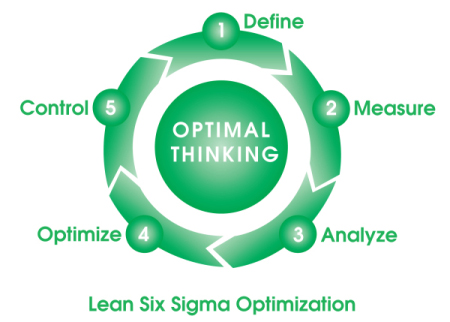Lean Six Sigma Optimization
You are probably wondering “How did Continuous Enterprise Optimization (CEO) come to fruition?” You are just getting used to Lean Six Sigma principles. Here’s a brief chronological description.
In the 1930’s, Frederick Taylor developed scientific management (Industrial Engineering) to bring work efficiency to industry. He was able to analyze work tasks by exploring the elements. However, product design and quality were still lacking.
 In the 1950’s, Dr. W. Edwards Deming developed statistical process improvement methods for product design and quality, and 14 key points for supporting a quality culture. He brought quality to product design and manufacturing in Japan. The coveted Deming prize for quality is named after him. Later on, his successes in Japan were revered in the United States.
In the 1950’s, Dr. W. Edwards Deming developed statistical process improvement methods for product design and quality, and 14 key points for supporting a quality culture. He brought quality to product design and manufacturing in Japan. The coveted Deming prize for quality is named after him. Later on, his successes in Japan were revered in the United States.
In the 1980’s, quality improvement process consciousness was expanded throughout entire enterprises. Customers demanded quality products and services. Total Quality System (TQS) became the best practice in progressive companies worldwide. At the same time, Six Sigma was popularized through Bill Smith’s work at Motorola to improve quality and minimize variability. Taiichi Ohno also developed the Toyota Production System (TPS) through continuous improvement and the relentless elimination of waste, revolutionizing the automobile industry in Japan.
Total Quality Management (TQM) became the norm in the 1990’s. Following lessons learned from the Toyota Production System, Womack and Jones introduced Lean Manufacturing in different industries in the United States. Dr. Michael Hammer expanded process improvement to the whole enterprise in Business Process Reengineering. Continuous Measurable Improvement became a corner stone in the defense industry to achieve quantifiable results.
In the early 2000’s, companies started to promote and practice Lean Six Sigma principles (LSS), combining the process improvement and waste elimination concepts, tools and techniques of Lean principles, and the quality improvement and variability minimization concepts, tools and techniques of Six Sigma principles. Continuous Service Improvement using similar concepts and tools started in the public sector. A fine example is the city of Ft. Wayne, Indiana.
 Sporting 60 years of combined work experience with people and corporations, Ed Lai, PE, MSIE and Rosalene Glickman, Ph.D. recognized the power of combining Optimal Thinking and the concepts, tools and techniques of Lean Six Sigma in early 2009. They had both witnessed successful Lean Six Sigma projects erode to a level of complacency where companies were no better off. Without Optimal Thinking, even the best results were not sustainable. As a result, they jointly developed Lean Six Sigma Optimization. While developing LSSO, Ed and Rosalene realized that an entirely new universal paradigm for achieving optimum results for the entire enterprise was necessary. This is when Continuous Enterprise Optimization (CEO) was born.
Sporting 60 years of combined work experience with people and corporations, Ed Lai, PE, MSIE and Rosalene Glickman, Ph.D. recognized the power of combining Optimal Thinking and the concepts, tools and techniques of Lean Six Sigma in early 2009. They had both witnessed successful Lean Six Sigma projects erode to a level of complacency where companies were no better off. Without Optimal Thinking, even the best results were not sustainable. As a result, they jointly developed Lean Six Sigma Optimization. While developing LSSO, Ed and Rosalene realized that an entirely new universal paradigm for achieving optimum results for the entire enterprise was necessary. This is when Continuous Enterprise Optimization (CEO) was born.
In the Optimal Thinking organization, employees continually focus on the highest priorities, develop optimal strategies, and do their best, regardless of the circumstances. Continuous Enterprise Optimization provides the finest concepts, tools and techniques to achieve the best quantifiable results in pursuit of the most important business challenges. When the consequences of failure are potentially detrimental, CEO implementation provides optimal contingency plans so that the organization is fully prepared for the risks, and has the best opportunities for success.
















